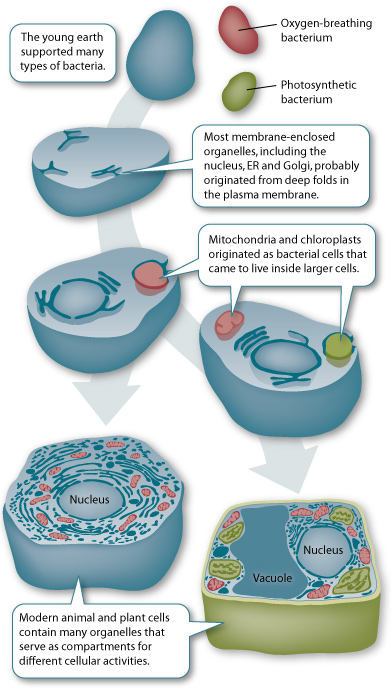Endosymbiotic Universe
November 8, 2011
Endosymbiosis occurred two separate times in Areiosan history. Part of the reason why animal life took so much longer to form on Areios is that two separate endosymbiotic events had to occur before the creation of mitochondria. The first major endosymbiotic event occurred when an errant virus was engulfed in an episode of transduction gone awry. Transduction is one way that viruses infect cells, stealing into their cytoplasm and hijacking the cellular machinery of the host cell to make copies. Somehow, this process was disrupted and while the virus had infected its host cell, it couldn’t wrest control from the cell’s RNA to make virus proteins. This cohabitation eventually proved to be a great opportunity for the cell because in the transduction event some of the virus’s DNA was mixed with the DNA of the host germ. What resulted was a fusion of the nucleic material of the virus with the nucleic material of the host. One of the biggest effects of this synthesis was the compartmentalization of the DNA from the rest of the cell. In bacteria, DNA is a free-floating piece of cyclical DNA that is exposed to the chemical reactions occurring inside the cytoplasm. By cordoning off the DNA, this cellular experiment provided a safer environment and offered an added bonus; other viruses had a harder time cracking the defenses of cells with nuclei. Although it started as a botched attempt at usurping a cell’s reproductive ability, this primordial endosymbiotic event ended with the creation of a new form of life.
The next endosymbiotic event was strongly influenced by environmental change. Oceans were becoming more acidic with the build-up of sulfur dioxide in the atmosphere that led to sulfuric acid raining down on the oceans. The rise of acidophiles in oceans sucked up the sulfate swashing around in the ocean when sulfuric acid dissociated. By intaking that sulfate and picking out the methane that dissolved of the ocean, these acidophiles could metabolize these inputs while excreting bicarbonate ions and reduced hydrogen sulfide gas. Living in such acidic environments would cause acidophiles to evolve mechanisms for thriving in conditions that would prove lethal for many other organisms. Acidophiles do this by pumping hydrogen ions out of their cytoplasm, so any organism that could hide inside of an acidophile would live in an environment that is much closer to a neutral pH than the oceans. Another issue that would prove daunting for life was that with pH dropping in the oceans, soluble toxic metals were getting leached from the geology and dissolved in anoxic environments, further poisoning any organism not adapted to living in brine laced with heavy levels of iron and other transition metals.
Nitrate levels are higher on Areios because nitric acid formed in the atmosphere and would dissociate into hydrogen and NO3–. This acid would dissolve into the oceans and prove poisonous to Areiosan acidophiles as well. So an organism similar to the Beggiatoa species on Earth appeared that was primed to overcome this dilemma. Not only can Beggiota metabolize nitrate and hydrogen sulfide to form waste products like ammonia and sulfate, but it can also store sulfur intracellularly and use this elemental sulfur as an energy source in the presence of oxygen to form sulfate. Originally, Beggiaota formed an endosymbiotic relationship with an archaean acidophile because Beggiaota could use any oxygen that enters the acidophile and burn its store of intracellular sulfur. Plus, it could store sulfate for times when sulfate levels dropped and release it into the cell when the concentration of sulfate in the host cell dropped. Here, a symbiotic relationship occurred where the acidophile lowered the survival costs of the Beggiaota by giving it safe harbor and in exchange, Beggiaota would provide a food source for the acidophile during times when food was scarce and eliminate any toxics that crept into its intracellular environment.
But when the oceans became more acidified, Beggiaota took on another purpose as well; it could take in nitrate from the environment and turn it into ammonia. Ammonia is a powerful base and when it comes in contact with the acidity of the ocean, it would form a salt that neutralizes the ocean. The emergence of this early eukaryote profoundly manipulated the chemistry of the planet; as time progressed, the composition seawater changed as dissolved chemicals like sulfate, nitrate, methane and hydrogen sulfide were replaced by chemicals like bicarbonate and ammonia. This profoundly altered the biosphere and the composition of the atmosphere because it brought the pH of the planet back up to neutral after the build-up of gases in the atmosphere from outgassing dropped the pH. This constant battle between acids and bases is evidenced by the near-constant salt concentration in the Areiosan Ocean since the advent of eukaryotic life.
